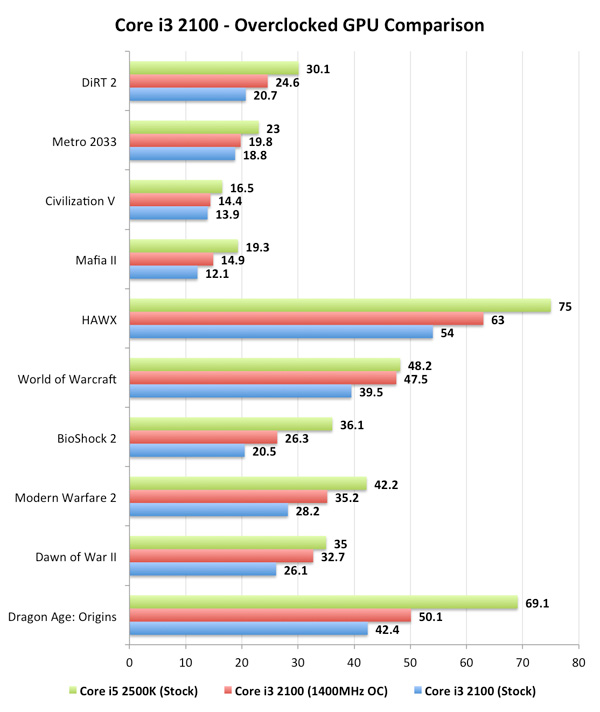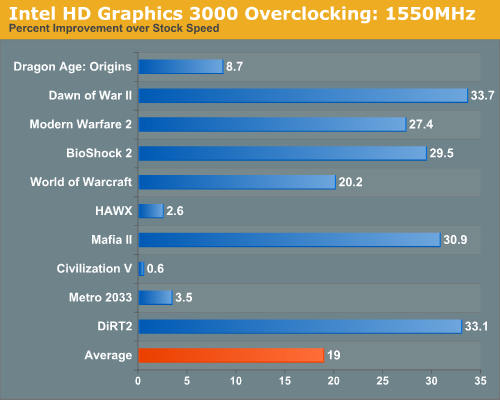The Sandy Bridge Review: Intel Core i7-2600K, i5-2500K and Core i3-2100 Tested
by Anand Lal Shimpi on January 3, 2011 12:01 AM ESTOverclocking Intel's HD Graphics
The base clock of both Intel's HD Graphics 2000 and 3000 on desktop SKUs is 850MHz. Thankfully, Intel's 32nm process allows for much headroom in both the CPU and GPU for overclocking. There are no clock locks or K-series parts to worry about when it comes to GPU overclocking; everything is unlocked. I started by trying to see how far I could push the Core i3-2100's HD Graphics 2000.
While I could get into Windows and run games at up to 1.6GHz, I needed to back down to 1.4GHz to maintain stability across all of our tests. That's a 64.7% overclock:

In some cases (Civilization V, WoW, Dawn of War II), the overclocked HD Graphics 2000 was enough to bring the 6 EU part close to the performance of the 3000 model. For the most part however the overclock just helped the Core i3-2100 perform halfway between it and the Core i5-2500K.
I tried the same experiment with the Core i5-2500K. While there's no chance it could catch up to a Radeon HD 5570, I managed to overclock my 2500K to 1.55GHz (the GPU clock can be adjusted in 50MHz increments):

The 82.4% increase in clock speed resulted in anywhere from a 0.6% to 33.7% increase in performance. While that's not terrible, it's also not that great. It looks like we're fairly memory bandwidth constrained here.










283 Comments
View All Comments
auhgnist - Monday, January 17, 2011 - link
For example, between i3-2100 and i7-2600?timminata - Wednesday, January 19, 2011 - link
I was wondering, does the integrated GPU provide any benefit if you're using it with a dedicated graphics card anyway (GTX470) or would it just be idle?James5mith - Friday, January 21, 2011 - link
Just thought I would comment with my experience. I am unable to get bluray playback, or even CableCard TV playback with the Intel integrated graphics on my new I5-2500K w/ Asus Motherboard. Why you ask? The same problem Intel has always had, it doesn't handle the EDID's correctly when there is a receiver in the path between it and the display.To be fair, I have an older Westinghouse Monitor, and an Onkyo TX-SR606. But the fact that all I had to do was reinstall my HD5450 (which I wanted to get rid of when I did the update to SandyBridge) and all my problems were gone kind of points to the fact that Intel still hasn't gotten it right when it comes to EDID's, HDCP handshakes, etc.
So sad too, because otherwise I love the upgraded platform for my HTPC. Just wish I didn't have to add-in the discrete graphics.
palenholik - Wednesday, January 26, 2011 - link
As i could understand from article, you have used just this one software for all these testings. And I understand why. Is it enough to conclude that CUDA causes bad or low picture quality.I am very interested and do researches over H.264 and x264 encoding and decoding performance, especially over GPU. I have tested Xilisoft Video Converter 6, that supports CUDA, and i didn't problems with low quality picture when using CUDA. I did these test on nVidia 8600 GT and for TV station that i work for. I was researching for solution to compress video for sending over internet with low or no quality loss.
So, could it be that Arcsoft Media Converter co-ops bad with CUDA technology?
And must notice here how well AMD Phenom II x6 performs well comparable to nVidia GTX 460. This means that one could buy MB with integrated graphics and AMD Phenom II x6 and have very good encoding performances in terms of speed and quality. Though, Intel is winner here no doubt, but jumping from sck. to sck. and total platform changing troubles me.
Nice and very useful article.
ellarpc - Wednesday, January 26, 2011 - link
I'm curious why bad company 2 gets left out of Anand's CPU benchmarks. It seems to be a CPU dependent game. When I play it all four cores are nearly maxed out while my GPU barely reaches 60% usage. Where most other games seem to be the opposite.Kidster3001 - Friday, January 28, 2011 - link
Nice article. It cleared up much about the new chips I had questions on.A suggestion. I have worked in the chip making business. Perhaps you could run an article on how bin-splits and features are affected by yields and defects. Many here seem to believe that all features work on all chips (but the company chooses to disable them) when that is not true. Some features, such as virtualization, are excluded from SKU's for a business reason. These are indeed disabled by the manufacturer inside certain chips (they usually use chips where that feature is defective anyway, but can disable other chips if the market is large enough to sell more). Other features, such as less cache or lower speeds are missing from some SKU's because those chips have a defect which causes that feature to not work or not to run as fast in those chips. Rather than throwing those chips away, companies can sell them at a cheaper price. i.e. Celeron -> 1/2 the cache in the chip doesn't work right so it's disabled.
It works both ways though. Some of the low end chips must come from better chips that have been down-binned, otherwise there wouldn't be enough low-end chips to go around.
katleo123 - Tuesday, February 1, 2011 - link
It is not expected to compete Core i7 processors to take its place.Sandy bridge uses fixed function processing to produce better graphics using the same power consumption as Core i series.
visit http://www.techreign.com/2010/12/intels-sandy-brid...
jmascarenhas - Friday, February 4, 2011 - link
Problem is we need to choose between using integrated GPU where we have to choose a H67 board or do some over clocking with a P67. I wonder why we have to make this option... this just means that if we dont do gaming and the 3000 is fine we have to go for the H67 and therefore cant OC the processor.....jmascarenhas - Monday, February 7, 2011 - link
and what about those who want to OC and dont need a dedicated Graphic board??? I understand Intel wanting to get money out of early adopters, but dont count on me.fackamato - Sunday, February 13, 2011 - link
Get the K version anyway? The internal GPU gets disabled when you use an external GPU AFAIK.